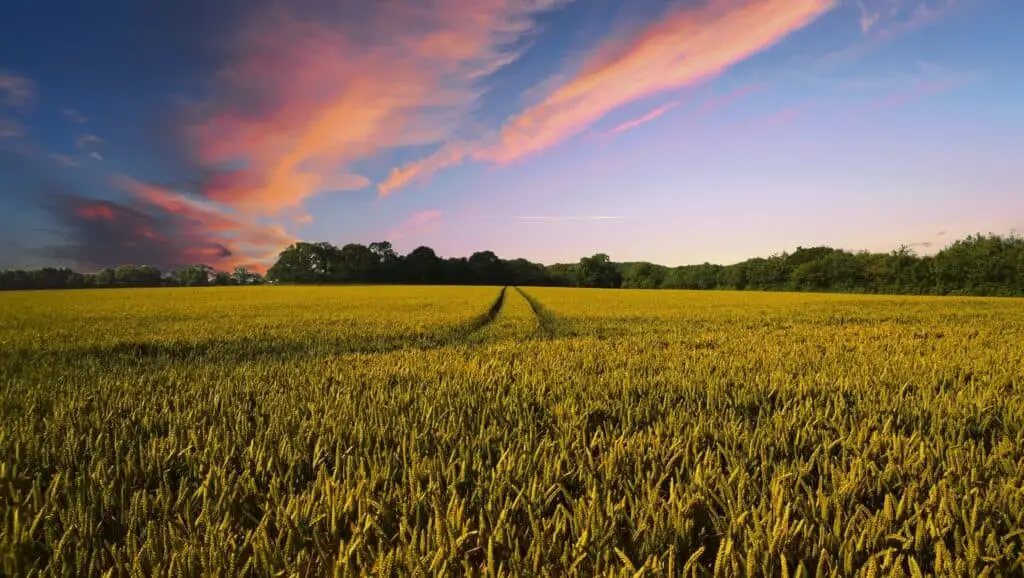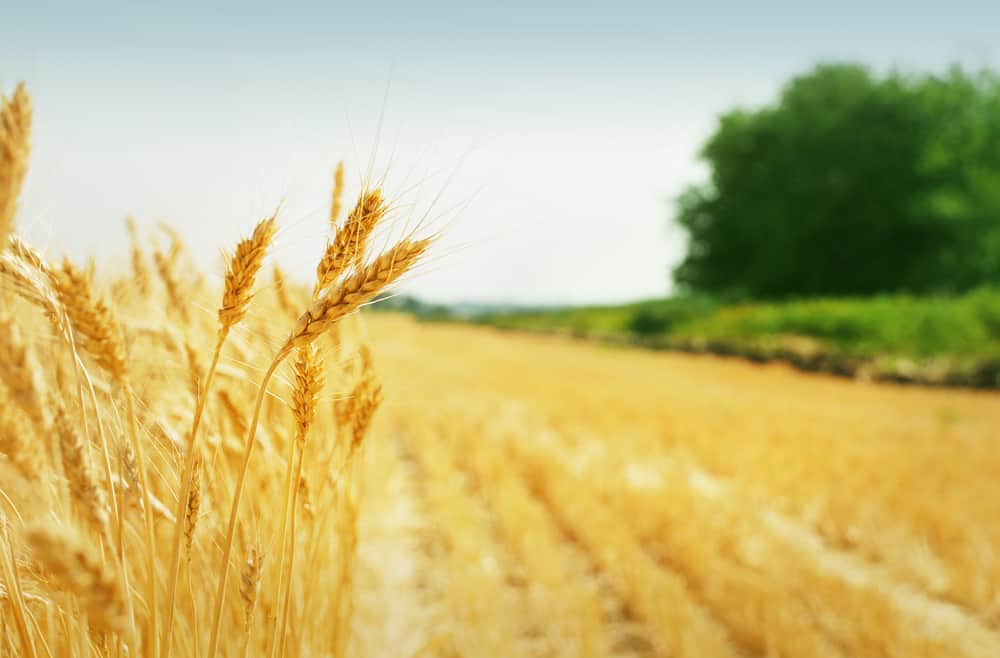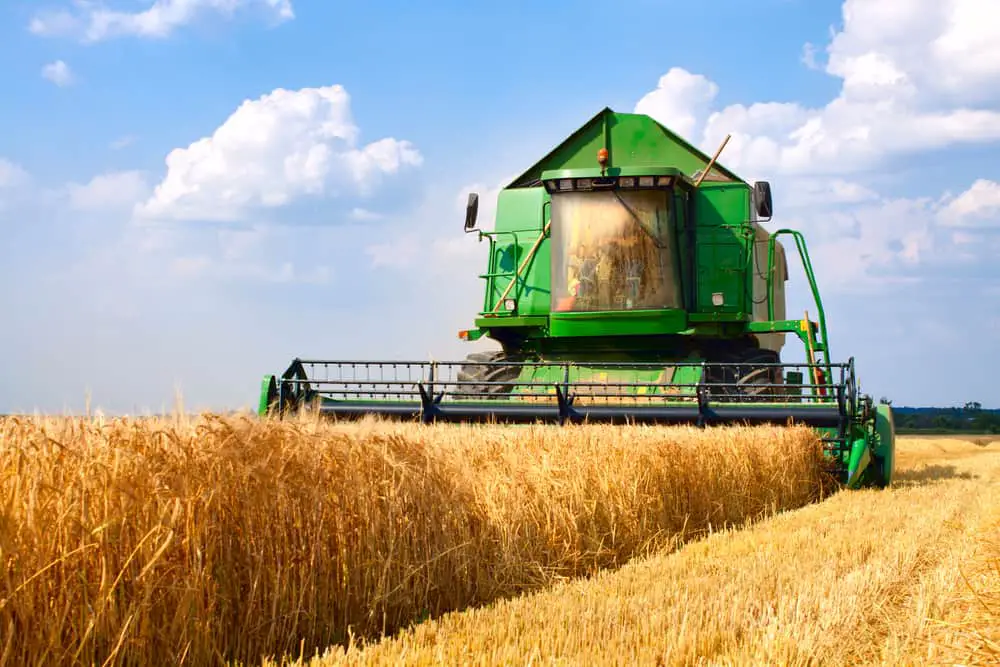Before you can use flour to make delicious bread and cakes, wheat plants must be farmed, harvested, and processed. In other words, there are a lot of steps that the plant must take before it gets to your food or table. Wheat farming is largely responsible for all of these steps.
To learn about wheat farming in the United States, read on. This article explains wheat farms by location, wheat farms by farming method, and more. Keep reading for more information about wheat farming.
What Is Wheat Farming?
Wheat farming is the act of planting, growing, and harvesting wheat varieties. In the United States, nearly every state has some wheat farming locations, though the majority of wheat farming happens in the Great Plain areas of the country.
Of course, the United States is not the only country with wheat farming. In fact, three other countries have more wheat farming operations than the United States. China, India, and Russia are the top three countries with the highest amounts of wheat production. The United States comes in fourth.
Regardless of the farm in question, the vast majority of wheat farms are responsible for planting the seed and loading the harvested kernels into containers and semi-trucks to be processed. From there, the manufacturers and producers take over.
Wheat Farming in America
Wheat farming is an important industry in the United States. Just behind corn and soybeans, wheat production is the third most important US crop in terms of production, planted acreage, and financial earnings. In some states, wheat is even the main money source for their economy.

Wheat Farm Designs in the US
Most wheat farms in the United States are designed based on their location and what variety of wheat is being grown. Most wheat is separated into two seasons: winter and spring. In the United States, nearly 70% of wheat produced falls into the winter category.
Still, most wheat farms in the US have the same design. Wheat farms are specifically designed for growing the plant, not processing them. As a result, most wheat farms in the US include a lot of agricultural space for the wheat to grow. Certain farms may also have dry areas to store the wheat, but many ship off harvested wheat as soon as possible.
Wheat Farms In Texas
Texas is one of the most important states for American agriculture. It has the largest number of farms and ranches. The most important crops in Texas are corn, feed grain, and wheat, specifically winter wheat. In 2020 alone, Texas was responsible for 61,500 bushels of wheat for every 1,000 bushels.
Even though Texas is the number one agriculture state, they aren’t the leading wheat-producing state. In fact, there are eight other states that produce more wheat than Texas. The leading state for wheat production is North Dakota. They produced 312,782 bushels of wheat for every 1,000 bushels.
Wheat Farming in the Great Plains
The United States is divided into various regions, one of which being the Great Plains. The Great Plains refers to the flatlands that are West of the Mississippi River but east of the Rocky Mountains.
The states that fall into Great Plains category include Kansas, Nebraska, North Dakota, South Dakota, Colorado, Iowa, Minnesota, Missouri, Montana, New Mexico, Oklahoma, Texas, and Wyoming.
When it comes to wheat farming, the Great Plains is the most important area in the United States. In total, there are about 27 million acres dedicated to wheat alone in the Great Plains area. As a result, over 60% of American wheat is grown in the Great Plains.
Local Wheat Farms in the United States
Although most of the big wheat farms are located in the Great Plains, there are smaller wheat farms in about 42 states. For example, there are local wheat farms in the Midwest and Southeast.
Local wheat farms differ from commercial wheat farms in that the wheat is primarily sold to the surrounding citizens and used by the farmers. Often, local wheat farms grow and process their own wheat. Consequently, local wheat farms often have big silos to hold their wheat.
Types of Wheat Farming
Something that a lot of people don’t know is that there are different types of wheat farms out there. The style of wheat farming often depends on the farm size and its location. Let’s take a look at these different types of wheat farms to understand how the farming style differs from farm to farm.
Grain Farming

Before diving into the specific types of wheat farms, know that wheat farms are technically classified as grain farms. That’s because wheat is a type of grain. Sometimes, grain farms will have different types of grains, not just one, and rotate the crops to keep the land as healthy as possible.
Dry Wheat Farming
One of the more popular wheat farming styles is called dry wheat farming. It came about in the 19th century so that it would accelerate crop production in areas where rainfall averages 8 to 20 inches a year. Because of the nature of this farming style, it is incredibly popular in the Great Plains and the state of California.
Dry farming does not use supplemental irrigation during the dry season. Instead, this farming style produces the crops when the season is dry, but it uses the moisture that is preserved within the soil from the past rainy season.
This unique approach to wheat farming revolutionized wheat production in the United States. This method is largely responsible for the gigantic boom in wheat production in drier climates.
Micro Wheat Farming
Micro wheat farming is an option for individuals who want a high yield farm without catering to commercial purposes. Micro farms are primarily seen at local farms because they are small in size and environmentally mindful. Most often, micro farms take place on lands with less than five acres.
For wheat specifically, micro farms are ideal for homesteaders and others who want to provide a sustainable lifestyle for themselves. It also does not require any paid labor and is great for the environment. Of course, it isn’t as profitable as the other options since it simply can’t produce enough wheat for large-scale commercial purposes.
Organic Wheat Farming
Organic farming aims to grow crops without any commercial fertilizers, pesticides, preservatives, and growth regulators. Instead, farming methods rely on old-school methods to produce foods with fewer chemicals and synthetic additions.
Because wheat is one of the most mass-produced crops, many people are pushing for organic wheat farming. Many organic wheat farms often involve growing other cereals and crop rotation. Often, organic wheat farms opt for more natural species of wheat, such as emmer wheat.
Environmental Impacts of Wheat Farming

As great as wheat farming maybe for our palates and taste buds, wheat farming has serious environmental impacts.
Fertilizers that are used to grow wheat are responsible for 43% of all greenhouse gas emissions. These fertilizers are by far the worst aspect of wheat farming for the environment. In addition to greenhouse gas emissions, fertilizers and other chemicals can get into the ground and water systems to negatively affect other parts of the environment too.
Ways To Counteract The Problem
In order to decrease the environmental impacts of farming, experts recommend only planting and optimal times, zero tillage, fertilizer management, crop residue incorporation, intercropping, and improved storage techniques.
Another way to combat the problem includes focusing on local and small-scale wheat farms instead of commercial ones. This makes organic farming and micro farming advantageous to commercial farming in terms of environmental impacts.
Unfortunately, many wheat farms are not looking to incorporate these ideas into their system anytime soon. The reason for this is that it costs a lot of money in order to incorporate environmentally friendly methods into the entire farm’s system.
Wheat Farming Facts
How Long Does It Take Wheat To Grow?
Wheat normally takes between seven and eight months to grow. Most often, wheat is planted in the fall so that it can grow in the winter and be harvested in either spring or early summer.
How Many Bushels is One Acre of Wheat?
On average, one acre of wheat is able to produce about 40 bushels. The exact amount may depend on the crop production, wheat type, and time of year.
How Is Wheat Processed?

After the wheat plant has ripened fully, modern farmers use a combined harvester to collect all of their wheat. For farms without access to combined harvesters, sickles, scythes, and flails are used instead. These tools simply remove the wheat plant from the ground.
After that, the head or spike will be cut off the wheat plant. The spikes are then thrashed to remove the individual grains from the head, which is called the chaff. The seeds will then be cleaned and taken to a mill where they will be further processed.
Most often, the seeds are broken down to separate the bran, endosperm, and germs. There are many methods for separating these parts. Most often, farmers use grinding stones and cylinders to crush the kernels, but there are other steps and methods that differ from plant to plant.
Final Thoughts
Wheat takes a lot of resources, skill, and land to produce. As a result, wheat farming is an integral part of our culture and world. Hopefully, wheat farmers will find ways to improve the growing system so that it isn’t as damaging to the environment.
